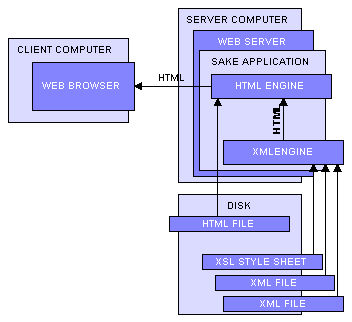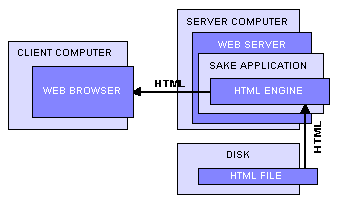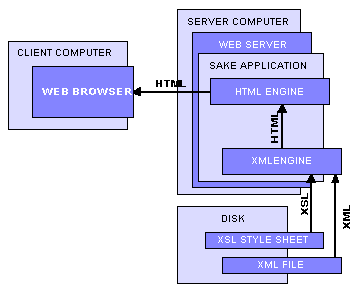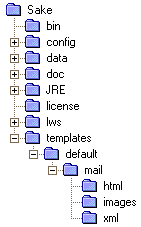Structure
The interface that a Saké application exposes to end-users
is entirely defined by a set of template
files that describe the HTML that Saké produces. Say that
a user accesses, for instance, the initial login page of Saké
Mail. First, Saké will check to see if the template corresponding
to the login page (called "t_nf_login"
in this case, the "NF" indicating "no-frames")
has already been loaded, processed, and cached. If it has, then
Saké Mail will modify the template on-the-fly with necessary
information such as error messages or user data, and spit out
the HTML-based login page to the user's browser. If the template
has not been loaded already then Saké will automatically locate
the template file, load it into memory, parse it, and cache
the results. This way, the loading operation only happens once
and future invocations of Saké Mail that call for a display
of the login page will finish in a fraction of the time that
it took to initially load the template. See Figure 1:
 |
| Figure
1: Saké uses template files, stored on the disk of the
web server that Saké is installed on, to define its entire
interface. |
Since the entire interface works this
way, you can completely customize the look of the entire application
by modifying the template files that are stored on disk as part
of your Saké installation. If you would like to change the background
color of an entire application, for instance, you can simply
open the template file and locate the specification for the
background color and change it. The next time that Saké loads
the modified template to create a page, it will produce output
with your new background color instead of our original 'out-of-the-box'
colors. If you want to change the layout of the frames, add
advertising banners, translate the interface into Slovenian,
anything that you like, all of these tasks can be accomplished
simply by modifying template files.
Saké template files come
in two different flavors, and you can use whichever you are
more comfortable with. The simplest option of the two is simple
HTML templates. With HTML templates, each template file that
is stored in your Saké installation is a valid HTML file that
can be edited with any standards-compliant HTML editor. As you
make modifications to the HTML files, you can restart Saké and
see the results. Using simple HTML file templates is very similar
to 'normal' web development with a web server. See figure 2:
 |
| Figure 2: HTML template files take a fairly simple
path to the end user. |
The other option is to use XML/XSL
templates. If you use the mechanism, then Saké will combine
each interface template with a single XSL style sheet called
"style.xsl" to create an
HTML template on-the-fly. (See Figure 3) This is a bit more
complex than using simple HTML files primarily because if you
use XML templates then you will probably not be able to use
the off-the-shelf HTML editing tools that you are used to. The
benefit of using XML templates is that you can use the XSL style
sheet to make application-wide changes by editing a single file.
To change the background color or image of every single page
in the entire application, for instance, all that you need to
do is edit a few lines in the XSL style sheet, and the next
time that the Saké application loads its templates your changes
will affect every single page in the application. We have made
every effort to centralize style elements into the XSL style
sheet in our out-of-the-box template set, to demonstrate the
power of server-side XSL.
 |
| Figure
3: XML template files are combined with XSL style sheets
on-the-fly to create HTML templates. |
In order to actually modify the interface
for a Saké application, first specify whether you are going
to be using XML or HTML templates. Most people prefer using
XML templates, and we highly recommend them, so the default
is XML. If you want to change the type of template, modify the
"sake.templatetype" setting
in the initialization file for the application. For more information
on this and other settings in the initialization file, see the
configuration documentation.
 |
| Figure
4: The "templates"
directory under the Saké installation tree. |
Once you have selected the
type of template that you would like to use, locate the templates
that you will be modifying. The default templates will be located
under the "templates/default"
directory of your Saké installation, in a directory named for
the particular application that you are modifying. For example,
the default templates for Saké Mail will be in the "templates/default/mail"
directory of your Saké installation. If you are using XML templates,
then your templates will be files called "t_*.xml"
in the "xml" directory
of your application's templates, and if you are using HTML templates
then your templates will be files called "t_*.htm"
in the "html" directory.
If you are using XML templates, then the contents of the "html"
directory will be completely ignored. Likewise, if you are using
HTML templates, then the contents of the "xml"
directory will be ignored. Images used by Saké will be files
that begin with "i_", located
in the "images" directory.
See Figure 4.
We provide a template set
in our "out-of-the-box" style (Endymion colors) in
both XML and HTML formats. We generated the HTML files automatically
from the XML files before we packed your distribution. For obvious
reasons, we recommend making a backup of your template files
before making any modifications.
 |
| Figure 5: Three new skins in addition to the
"default" skin: a skin for "xcorp",
a skin for "ycorp", and one for "zcorp". |
Skins
In some situations, it may be necessary for a single Saké installation
to provide several different interfaces to different people.
If a web hosting company, for example, wishes to resell the
functionality of some Saké application to their own clients,
then they may also wish to have the option of customizing the
interface of a Saké application differently for each client.
Saké provides this functionality through a mechanism known as
"skins". A skin is simply a name for a set of templates
that a Saké application can use to generate output at runtime.
By default, a Saké application uses the skin called "default",
which is why the templates for a directory are stored in the
"templates/default" directory
of your Saké application. In order to use a different skin,
create a set of templates and store them in a directory adjacent
to "templates/default"
under the name that you would like to give your new skin. For
example, in Figure 5, we have created three new skins in addition
to the "default" skin,
a skin called "xcorp",
one called "ycorp", and
one called "zcorp".
Note that these skins contain only an "xml"
directory, which of course works fine as long as you are using
XML templates.
In order to use the different
template sets, specify the "sake.skin"
parameter to your application when you initially run it. For
example, if you have a Saké Mail installation set up at "http://www.yourserver.com/mail",
then you would invoke the default template set with the URL
"http://www.yourserver.com/mail"
as usual. You would invoke the "xcorp"
skin at the same installation with "http://www.yourserver.com/mail?sake.skin=xcorp",
the "ycorp" skin with "http://www.yourserver.com/mail?sake.skin=ycorp",
and so on. Ordinary end-users generally can't be expected to
remember such an explicit URL, but in most cases your Saké applications
will be accessed via a link anyway. Simply encode the parameter
in the link from your static site that leads users to your application.
Saké licenses limit the number
of skins for a Saké installation in most cases, but adding new
skins to an additional installation is much cheaper and simpler
than setting up an installation for each company. You can think
of skins as being similar to virtual domains for a web server.



